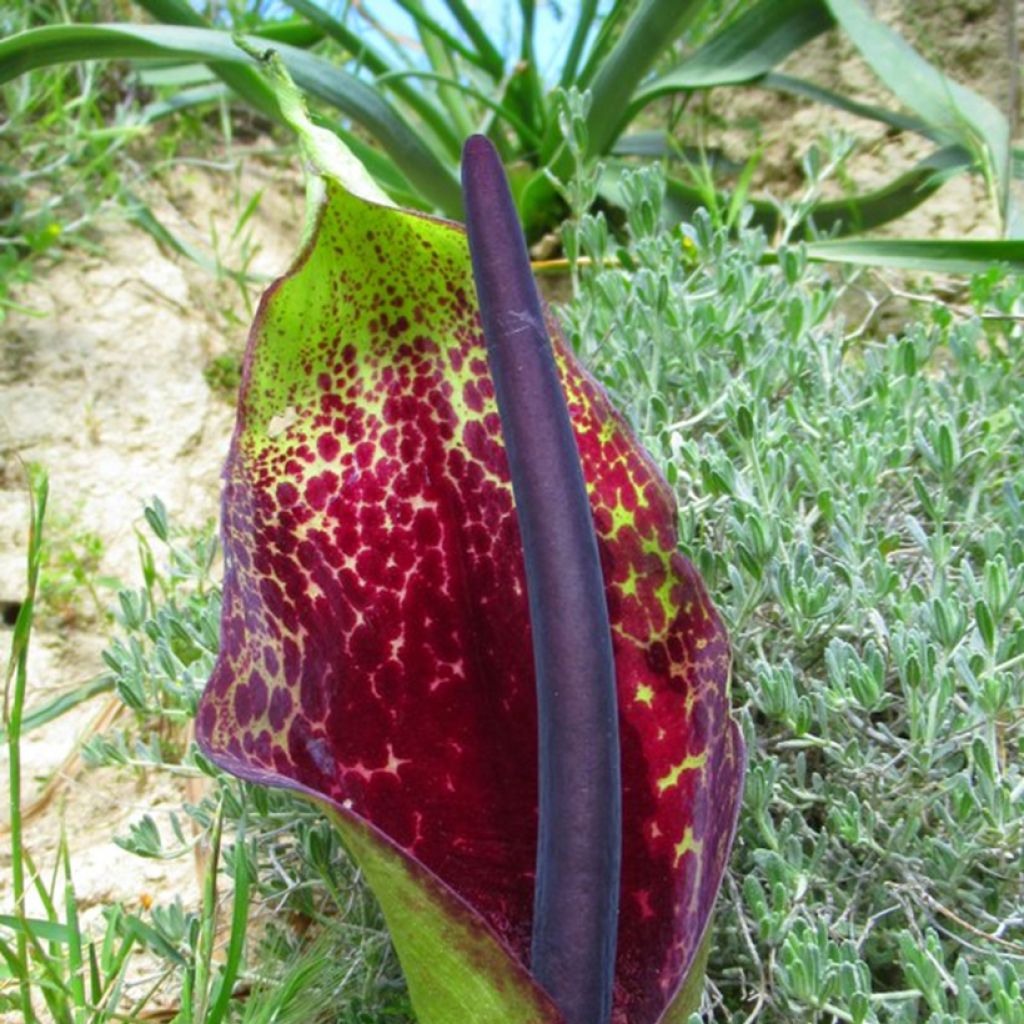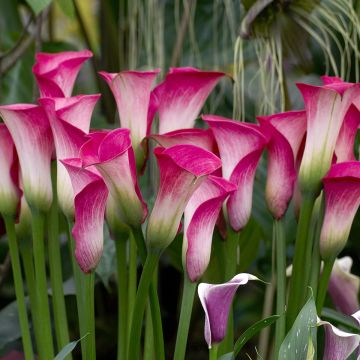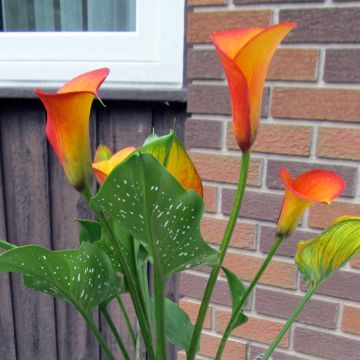

Arum dioscoridis


Arum dioscoridis


Arum dioscoridis
Arum dioscoridis
Arum dioscoridis
Spotted Arum, Leopard Arum
Special offer!
Receive a €20 voucher for any order over €90 (excluding delivery costs, credit notes, and plastic-free options)!
1- Add your favorite plants to your cart.
2- Once you have reached €90, confirm your order (you can even choose the delivery date!).
3- As soon as your order is shipped, you will receive an email containing your voucher code, valid for 3 months (90 days).
Your voucher is unique and can only be used once, for any order with a minimum value of €20, excluding delivery costs.
Can be combined with other current offers, non-divisible and non-refundable.
Why not try an alternative variety in stock?
View all →This plant carries a 6 months recovery warranty
More information
We guarantee the quality of our plants for a full growing cycle, and will replace at our expense any plant that fails to recover under normal climatic and planting conditions.
Would this plant suit my garden?
Set up your Plantfit profile →
Description
The Arum dioscoridis, sometimes called Dioscoride's arum, is a perennial tuberous plant that grows spontaneously from the east of the Mediterranean to the Middle East. Its vegetation cycle, adapted to Mediterranean-type climates, is characterized by the appearance of beautiful exotic foliage in autumn, which remains evergreen throughout the winter and disappears after flowering. In spring, the plant produces a decorative, spotted spathe inflorescence with a strong smell. This perennial naturalizes in natural and wild Mediterranean gardens. Elsewhere, enthusiasts of unusual arums can also grow it in pots, which makes it easier to meet its requirements.
The Arum dioscoridis is a perennial herbaceous and tuberous plant. It belongs to the Araceae family. It is a species found in southern Europe (Greece), western Asia (Turkey), Lebanon, and Syria. In nature, it is found in undergrowth, fallow land, among crops, on slopes, up to 2500 m altitude. This plant thrives in a Mediterranean climate characterized by humid winters and dry summers. The beautiful leaves of Arum dioscoridis are elongated, lanceolate-shaped, strongly veined, measuring between 13 and 45 cm long and 9 to 27 cm wide. Their color is a beautiful bright green, slightly glossy. They are carried by a petiole that can reach 50 cm long. Flowering occurs in April or May. The plant produces unisexual flowers (either male or female), grouped in spadices measuring 12 to 28 cm long, with a fusiform reddish-brown appendix. The spadices are surrounded by a lanceolate to elliptical lanceolate spathe, 11 to 40 cm long, greenish-yellowish in color, speckled with purple, reddish-brown, or violet depending on the strains. Pollination is carried out by small flies attracted by the strong acrid odor of the spadix. The fruits, shaped like elongated pears, measure from 5 to 11 mm long and 4 to 6 mm in diameter. Arum dioscoridis is hardy up to zone 8 (-12°C), but it does not like overly rainy summers. This plant self-seeds in the garden without becoming invasive.
Thriving on the edge of the undergrowth or even in dense shade, Arum dioscoridis is perfect for dressing the ground in winter with its beautiful foliage. It can also be used to beautify a shaded rockery. It is a natural garden plant, and the smell of its flowering can be overpowering: place it far enough from the house or high-traffic areas. It can be associated with ferns for dry soil, acanthus, Arum italicum subsp. italicum Marmoratum, and Dracunculus vulgaris in a garden in the South of France. It can also be planted en masse under an evergreen shrub hedge.
Note: all parts of the plant are toxic if ingested due to the saponins and various alkaloids contained in the leaves, fruits, and rhizome.
Report an error about the product description
Plant habit
Flowering
Foliage
Botanical data
Arum
dioscoridis
Araceae
Spotted Arum, Leopard Arum
Southern Europe
Other Arums
View all →Planting and care
Plant Dioscoride's arum in late summer or early autumn, in a semi-shaded or shaded position, in a fertile, humus-bearing soil, even clayey or limestone, but well-drained. Summer drought is well tolerated, as it corresponds to the plant's resting period. Not demanding on soil type, this plant also tolerates sandy and slightly acidic soils. Morning sun is tolerated in cooler regions, while partial shade is preferred in dry and hot climates. This species does not like overly wet soils in summer. Its cold resistance is around -12 °C at its lowest, in a well-drained soil.
Planting period
Intended location
Care
This item has not been reviewed yet - be the first to leave a review about it.
Haven't found what you were looking for?
Hardiness is the lowest winter temperature a plant can endure without suffering serious damage or even dying. However, hardiness is affected by location (a sheltered area, such as a patio), protection (winter cover) and soil type (hardiness is improved by well-drained soil).

Photo Sharing Terms & Conditions
In order to encourage gardeners to interact and share their experiences, Promesse de fleurs offers various media enabling content to be uploaded onto its Site - in particular via the ‘Photo sharing’ module.
The User agrees to refrain from:
- Posting any content that is illegal, prejudicial, insulting, racist, inciteful to hatred, revisionist, contrary to public decency, that infringes on privacy or on the privacy rights of third parties, in particular the publicity rights of persons and goods, intellectual property rights, or the right to privacy.
- Submitting content on behalf of a third party;
- Impersonate the identity of a third party and/or publish any personal information about a third party;
In general, the User undertakes to refrain from any unethical behaviour.
All Content (in particular text, comments, files, images, photos, videos, creative works, etc.), which may be subject to property or intellectual property rights, image or other private rights, shall remain the property of the User, subject to the limited rights granted by the terms of the licence granted by Promesse de fleurs as stated below. Users are at liberty to publish or not to publish such Content on the Site, notably via the ‘Photo Sharing’ facility, and accept that this Content shall be made public and freely accessible, notably on the Internet.
Users further acknowledge, undertake to have ,and guarantee that they hold all necessary rights and permissions to publish such material on the Site, in particular with regard to the legislation in force pertaining to any privacy, property, intellectual property, image, or contractual rights, or rights of any other nature. By publishing such Content on the Site, Users acknowledge accepting full liability as publishers of the Content within the meaning of the law, and grant Promesse de fleurs, free of charge, an inclusive, worldwide licence for the said Content for the entire duration of its publication, including all reproduction, representation, up/downloading, displaying, performing, transmission, and storage rights.
Users also grant permission for their name to be linked to the Content and accept that this link may not always be made available.
By engaging in posting material, Users consent to their Content becoming automatically accessible on the Internet, in particular on other sites and/or blogs and/or web pages of the Promesse de fleurs site, including in particular social pages and the Promesse de fleurs catalogue.
Users may secure the removal of entrusted content free of charge by issuing a simple request via our contact form.
The flowering period indicated on our website applies to countries and regions located in USDA zone 8 (France, the United Kingdom, Ireland, the Netherlands, etc.)
It will vary according to where you live:
- In zones 9 to 10 (Italy, Spain, Greece, etc.), flowering will occur about 2 to 4 weeks earlier.
- In zones 6 to 7 (Germany, Poland, Slovenia, and lower mountainous regions), flowering will be delayed by 2 to 3 weeks.
- In zone 5 (Central Europe, Scandinavia), blooming will be delayed by 3 to 5 weeks.
In temperate climates, pruning of spring-flowering shrubs (forsythia, spireas, etc.) should be done just after flowering.
Pruning of summer-flowering shrubs (Indian Lilac, Perovskia, etc.) can be done in winter or spring.
In cold regions as well as with frost-sensitive plants, avoid pruning too early when severe frosts may still occur.
The planting period indicated on our website applies to countries and regions located in USDA zone 8 (France, United Kingdom, Ireland, Netherlands).
It will vary according to where you live:
- In Mediterranean zones (Marseille, Madrid, Milan, etc.), autumn and winter are the best planting periods.
- In continental zones (Strasbourg, Munich, Vienna, etc.), delay planting by 2 to 3 weeks in spring and bring it forward by 2 to 4 weeks in autumn.
- In mountainous regions (the Alps, Pyrenees, Carpathians, etc.), it is best to plant in late spring (May-June) or late summer (August-September).
The harvesting period indicated on our website applies to countries and regions in USDA zone 8 (France, England, Ireland, the Netherlands).
In colder areas (Scandinavia, Poland, Austria...) fruit and vegetable harvests are likely to be delayed by 3-4 weeks.
In warmer areas (Italy, Spain, Greece, etc.), harvesting will probably take place earlier, depending on weather conditions.
The sowing periods indicated on our website apply to countries and regions within USDA Zone 8 (France, UK, Ireland, Netherlands).
In colder areas (Scandinavia, Poland, Austria...), delay any outdoor sowing by 3-4 weeks, or sow under glass.
In warmer climes (Italy, Spain, Greece, etc.), bring outdoor sowing forward by a few weeks.













































